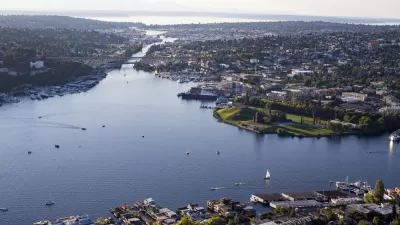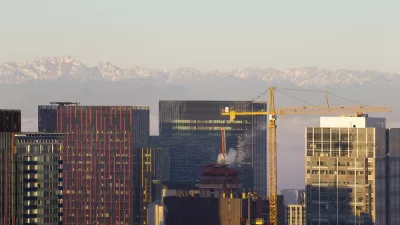The Seattle 2035 will manage growth for one of the fastest growing cities in the country. But shouldn't it also mitigate the greenhouse gas emissions of this famously eco-conscious city?
Josh Feit reviews the current options under consideration for Seattle's ongoing comprehensive planning process. Seattle 2035, as the comprehensive plan is currently called, will lay out the city's planning agenda over the next 20 years—a period when the city is expected to add 120,000 new residents, 115,000 new jobs, and 70,000 new units.
Feit details each of the four conceptual options currently under consideration for the plan (i.e., urban villages, urban centers, transit oriented urban villages around light rail, and transit oriented urban villages around light rail and major bus hubs) and the engagement and feedback at a recent public hearing on the plan.
Feit, concludes, however, with a strong critique of the plan's lack of ambition in reducing greenhouse gas emissions. According to the consultants leading the public hearing, the plan would achieve small reductions in greenhouse gas emissions. Feit's response to such a low bar:
"Growth management is precisely about fighting global warming. Yes, with 120,000 new people and 70,000 new units, Seattle’s carbon footprint, would, mismanaged, increase. And a slight decline with so much growth might be seen as progress. But coordinating new density is actually an opportunity to transform our city into a bulwark against climate change. By seizing growth as a catalyst for transit oriented development built around urbanist and pedestrian values, Seattle could actually be facing a cure for wasteful GHG emissions. Growth induces efficiency."
FULL STORY: City Overlooking Opportunity to Fight Global Warming

Maui's Vacation Rental Debate Turns Ugly
Verbal attacks, misinformation campaigns and fistfights plague a high-stakes debate to convert thousands of vacation rentals into long-term housing.

Planetizen Federal Action Tracker
A weekly monitor of how Trump’s orders and actions are impacting planners and planning in America.

In Urban Planning, AI Prompting Could be the New Design Thinking
Creativity has long been key to great urban design. What if we see AI as our new creative partner?

Cal Fire Chatbot Fails to Answer Basic Questions
An AI chatbot designed to provide information about wildfires can’t answer questions about evacuation orders, among other problems.

What Happens if Trump Kills Section 8?
The Trump admin aims to slash federal rental aid by nearly half and shift distribution to states. Experts warn this could spike homelessness and destabilize communities nationwide.

Sean Duffy Targets Rainbow Crosswalks in Road Safety Efforts
Despite evidence that colorful crosswalks actually improve intersection safety — and the lack of almost any crosswalks at all on the nation’s most dangerous arterial roads — U.S. Transportation Secretary Duffy is calling on states to remove them.
Urban Design for Planners 1: Software Tools
This six-course series explores essential urban design concepts using open source software and equips planners with the tools they need to participate fully in the urban design process.
Planning for Universal Design
Learn the tools for implementing Universal Design in planning regulations.
Appalachian Highlands Housing Partners
Gallatin County Department of Planning & Community Development
Heyer Gruel & Associates PA
Mpact (founded as Rail~Volution)
City of Camden Redevelopment Agency
City of Astoria
City of Portland
City of Laramie




























